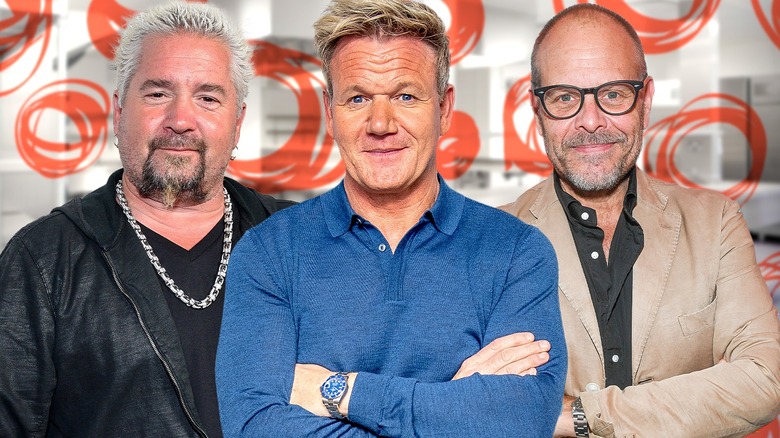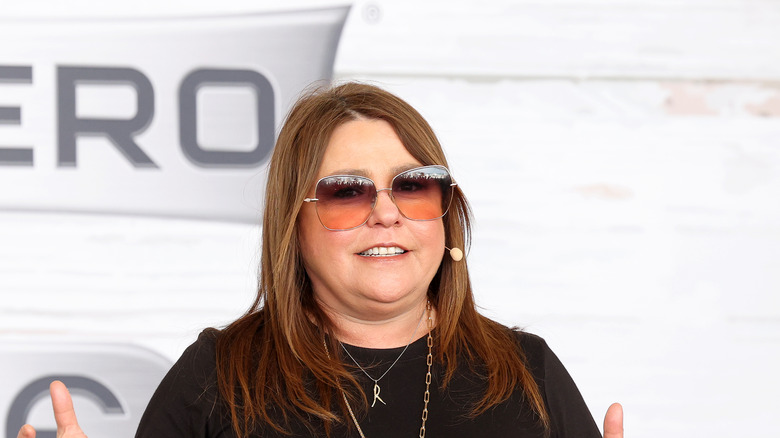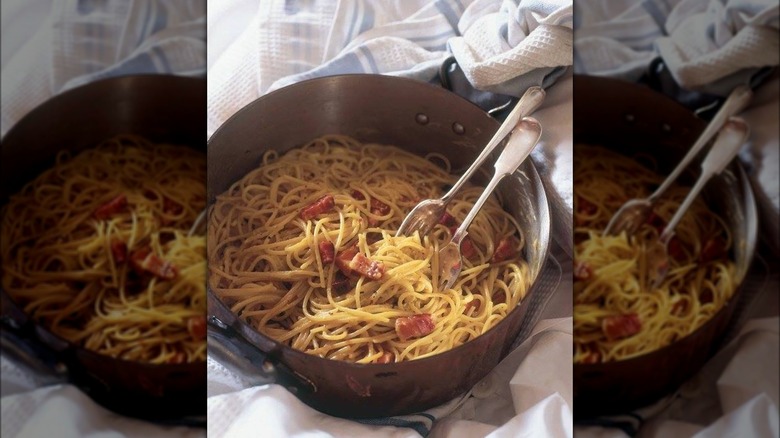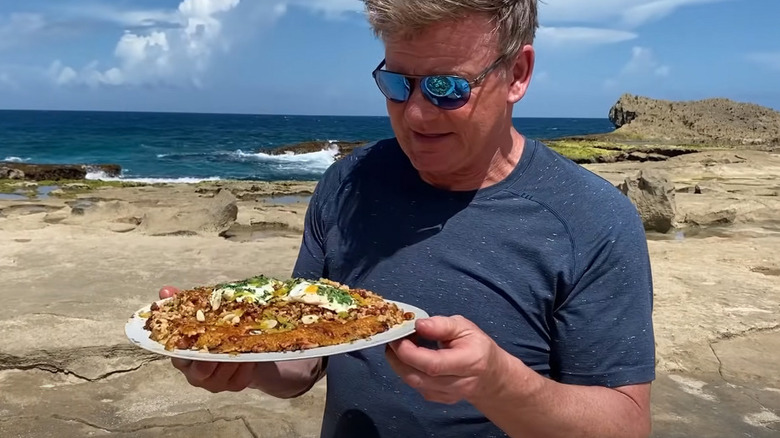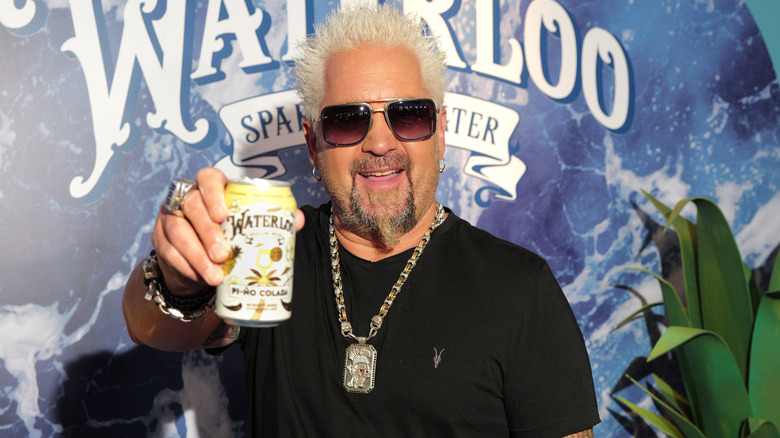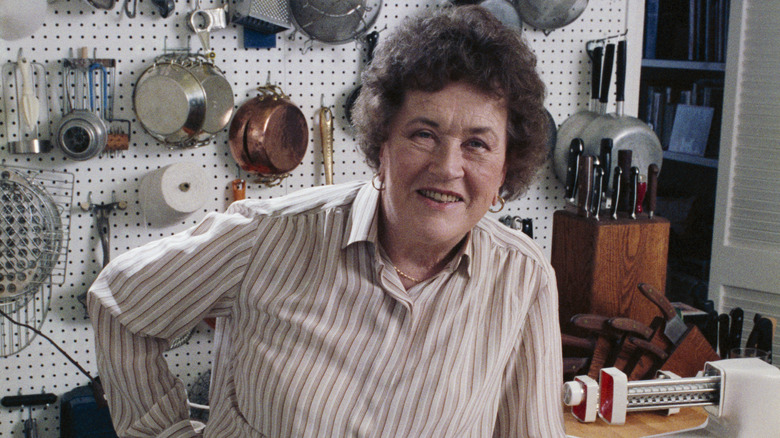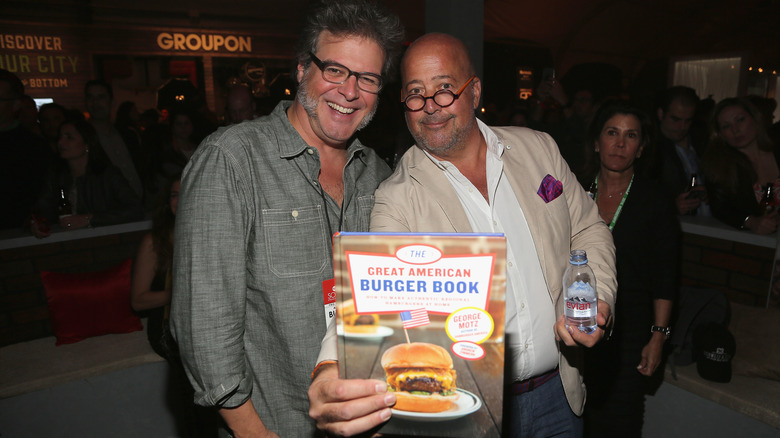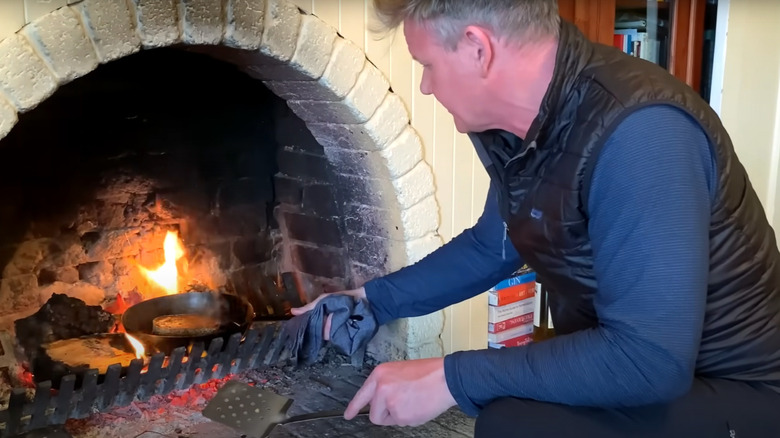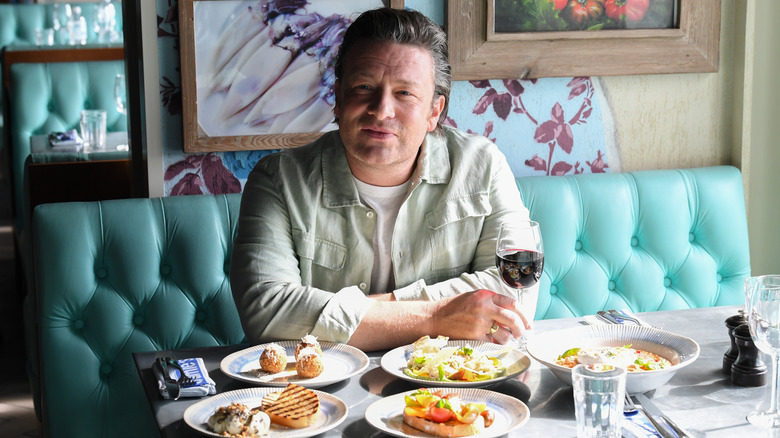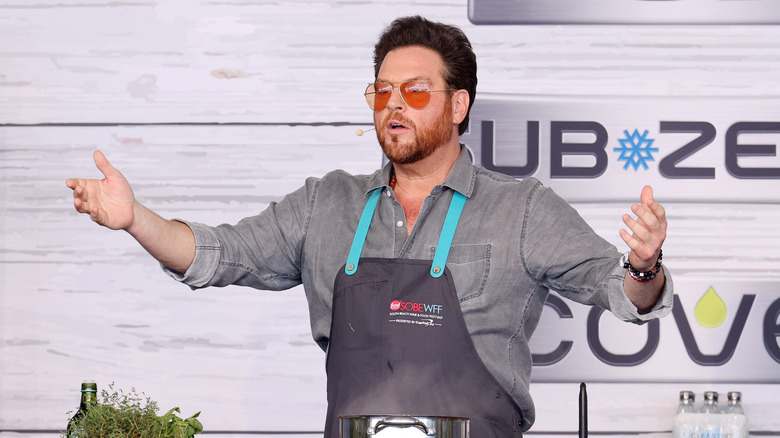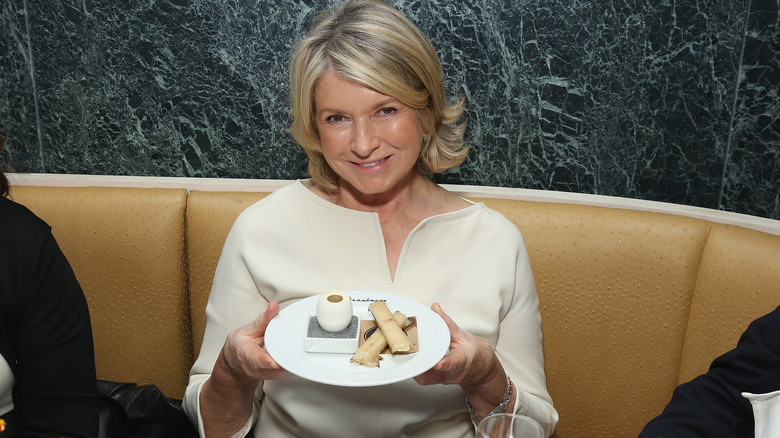Times Celebrity Chefs Gave Questionable Cooking Advice
When kitchen-dwellers turn on the Food Network to watch one of their favorite TV chefs they're typically looking for the tastiest recipes and the best tips from seasoned pros. When making their next meal these at-home amateur chefs expect to be getting the benefit of expert advice, giving them the confidence to make a great meal, even if they don't have a ton of culinary talent. But even the most acclaimed, award-winning, and downright best chefs in the business haven't always given the best kitchen advice.
While TV chefs like Gordon Ramsay, Bobby Flay, and Rachael Ray often deliver some of the best recipes you've ever tasted, they too are capable of slipping up and dishing out tips that make us do a double take. After all, nobody's perfect. It might be suggesting an ingredient that ruins a recipe or it could be experimenting a little too much with a traditional favorite. From a Guy Fieri feast gone wrong to Martha Stewart's poor shopping guidance, here's a list of TV chefs who've given questionable cooking advice.
Rachael Ray gave the worst advice for refried beans
When white TV chefs make international food it can spark controversy both for cultural appropriation and for screwing up a traditional dish. The latter is what happened to Rachael Ray when she cooked refried beans. She came under fire from Mexican chefs and casual cooks for screwing up the simple side dish.
Presented on TikTok to her followers ahead of the Super Bowl in 2022, Ray's method left a lot to be desired. First, she seemed to be putting her own spin on the dish, using chopped onions, grated garlic, and jalapeños, which many commenters said didn't belong. But the most head-scratching ingredient is hot sauce, which surely prompted swaths of viewers to cry out in protest. The addition of way too much water, which she said would help the vegetables cook, also raised quite a few eyebrows.
If all of that wasn't bad enough, Ray sent her critics through the roof when she tossed her awkward concoction into a food processor (just ... no). Then, she capped off the abomination by burning the edges, which she said was not only intentional but desired (scores of Latinx viewers dropped their jaws at the same time). Commenters were relentless, tearing Ray to shreds, with user Meow simply saying "Hell to the naw!" If you want something simpler, try Mashed's refried bean recipe, which doesn't require burning the beans.
Nigella Lawson totally ruined an Italian recipe
Rachael Ray certainly isn't the first celebrity chef to take serious heat for butchering a regional favorite from across the globe. In 2017, Nigella Lawson was also on the receiving end of some harsh fan backlash when she gave her own advice on how to cook carbonara.
A relatively simple pasta dish, classic carbonara typically includes lots of egg yolk, a grated hard cheese (often parmigiano reggiano or pecorino romano), a hefty portion of guanciale (cured pork jowl), and black pepper, which all combines to turn a traditional pasta into something with bold flavor that pays homage to the old world food of the Italian peninsula.
Lawson's recipe, however, called for some strange ingredients, most notably 60 milliliters of double cream, white wine, and nutmeg. Not only that, but she also doesn't separate the egg yolk from the white, making her version essentially scrambled eggs in pasta, and commenters weren't happy. When she posted on her Facebook page, commenters hit back at the TV chef, with many recoiling at her added ingredients and pointing out that her version of the dish is so far removed from classic carbonara that it's barely recognizable. Others defended her, saying it's ok to experiment and try something new. Still, if you're looking for a traditional carbonara, this ain't it, and Lawson probably would have been well-served to change the name of her recipe to avoid upsetting Italians who are overly familiar with the meal.
Gordon Ramsay proves has no idea how to make Puerto Rican food
Even chef extraordinaire Gordon Ramsay has given some cringe-worthy advice while presenting a favorite from another country. It happened in 2021 after Ramsay posted a video on his YouTube channel titled "Can Gordon Ramsay Make a Puerto Rican Crispy Rice Dish?" The answer from Puerto Ricans was a resounding "no."
In the video, Ramsay shows off his recipe for a dish called pegao. Like Lawson, Ramsay may have made a few too many small changes to a well-known staple and commenters on Twitter sounded off, saying that while it looked good, it wasn't pegao at all. Pegao, traditionally, is the term used for scorched rice, and it's not quite a dish unto itself, it's simply a way to serve rice as part of a meal. There are also specific ways to cook it to get it crispy, as opposed to burned. Ramsay seemed to know little about pegao, advising viewers to make it with eggs, beans, chicken, and sausage. The fact that the original title of the video was "Can Gordon Ramsay Elevate a Puerto Rican Rice Dish" also suggested that he thought his version was better than authentic pegao.
The Twitter account @SofritoProject – a self-proclaimed Puerto Rican rice enthusiast and chef — wasn't thrilled. "It's just frustrating to see white male chefs get applauded for doing the bare minimum (and incorrectly, for that matter) about cuisines they know nothing about and then get heralded as experts."
Guy Fieri's s'mores pizza is full of bad ideas
Not famous for his fancy food, Guy Fieri is known for down-to-earth recipes for blue-collar food like burgers, mac n' cheese, and barbecued ribs. Though his food is often straightforward, Fieri always does something fresh and fun, and recipes are usually a touch above what you'd find in a diner. That said, sometimes his efforts to appeal to backyard cooks go a little too far and in one infamous incident he provided a recipe he wishes we'd all forget.
Fieri's dessert pizza concoction, s'mores pizza, doesn't seem that awful on the surface — we've seen plenty of sweet dishes in a pizza shape for a fun picnic treat. But Fieri's recipe doesn't deliver the goods, with strange choices of toppings and awkward cooking methods turning it into a kitchen nightmare. For starters, fans of Fieri were thrown for a loop when they discovered how oddly spicy it was, thanks to the eye-popping inclusion of chili powder and cayenne pepper. Now, don't get us wrong, sometimes unexpected spiciness can make a dish better, but in this case, it's just horrendous, and many reviews said just that.
If the tip of adding spices to s'mores wasn't bad enough, though, somehow Fieri convinced a national chain to carry it. For a time, it was made available as a frozen, microwavable dessert at Sam's Club, and it wasn't any better in that form.
Julia Child says you can only cook with expensive wine
If there's a proverbial godmother of TV chefs it's Julia Child, whose first cooking show, "The French Chef," debuted in 1962. Child had a long career as a writer of cookbooks prior to that, and on television she became known for her effervescent personality, always having a good time in the kitchen — notable at a time when cooking was seen as more of a chore than the art form we often view it as today. She dispensed plenty of culinary wisdom to the masses, but not all of her advice was good.
While Child's books and TV shows focused on making and demonstrating elaborate meals in a way even unskilled cooks could handle, there's at least one tip that home chefs weren't happy to hear. "If you do not have a good wine to use, it is far better to omit it," Child once said (per the New York Times). "A poor one can spoil a simple dish and utterly debase a noble one." Over the years, that piece of advice has received plenty of flack from both ordinary cooks and professionals alike.
Of course, old, cheap, stale wines that have been sitting open for too long are definitely not good for cooking, but that doesn't mean that a fresh bottle of inexpensive wine won't do the trick. Just make sure it's not undrinkably bad.
George Motz doesn't think you should put ketchup on a burger
There are certain foods everyone knows how to dress: Hot wings are dipped in ranch or bleu cheese, salad needs croutons, and pasta can't be eaten without grated cheese. And we can probably all agree that a hamburger is almost always better with a healthy dollop of ketchup. Unless that is, you agree with George Motz, whose specialty is hamburgers.
The producer and star of 2004's "Hamburger in America" and 2013's "Burger Land," Motz has also appeared on "The Burger Show" and "The Burger Bucket List." Clearly, the man knows his burgers, so people perked up and listened when he had a controversial take on the blood-red topping. "One of the biggest burger faux pas is to put ketchup on your burger," he said (via Grub Street). "Ketchup is very sweet and it does not work with the beef like everybody thinks it does." According to Motz, ketchup only became common on burgers in the 1950s thanks to fast food chains' desire to lure in kids.
No matter how or why ketchup came to be common, though, there are scores of burger lovers who'd never go without it. That said, Motz isn't alone — many experts agree with him, and some high-end restaurants don't even offer the craved condiment. But ketchup lovers don't fret, because there are plenty of expert chefs who are with you on this, with the likes of Bobby Flay, Robert Irvine, and Emeril Lagasse all endorsing the red stuff.
Gordon Ramsay's grilled cheese tips make no sense at all
"Kitchen Nightmares" host Gordon Ramsay is known for his abrasive attitude. But there has been more than one occasion where he probably deserved the same kind of dressing down he's known for dishing out. In addition to butchering Puerto Rican pegao, Ramsay also got into a bit of a brouhaha after giving tips on making one of the simplest snacks ever devised: a grilled cheese sandwich.
In his recipe, which was posted as part of his YouTube series "Ramsay Around the World," the renowned TV chef tries to do something new and different, calling it the "Ultimate Grilled Cheese." But for most watching, it looked like a strange mess that barely resembled what anyone would consider a grilled cheese sandwich. For starters, he uses the most expensive ingredients, and way too much of them (do we need a 5-second pour of olive oil in the pan?). Don't get us started on his use of Korean kimchi, which everyone seemed confused by.
Worst of all, however, is his use of hard cheeses like romano (with pepperberry) and asiago, which is downright confusing, as they hardly even melt. The fact that he cooks it in a fireplace over too-high heat turns the entire video into a farce. We get it, Gordon, you can only make bougie food — please stop trying to "elevate." Sometimes cheap and simple is the best option.
Jamie Oliver's paella recipe was all wrong on every level
English restauranteur and TV host Jamie Oliver might be the quintessential celebrity chef, at least in theory. He appeals to everyone from experts who want high-caliber cooking all the way down to ordinary kitchen tinkerers who just want to learn the basics. Unfortunately, Jamie Oliver has made people angry many times, perhaps most infamously when he damaged the U.S. meat industry with comments about "pink slime." But it's not just his attitude towards cheap food manufacturing that bothers some viewers. In 2016 he detailed his recipe for paella with some very questionable choices, to say the least.
Authentic paella, of course, is a Spanish dish made with rice, your choice of protein, veggies, and plenty of saffron. Oliver's version, however, recommended using the spicy pork sausage chorizo, along with chicken thighs and peas, among other ingredients. Those who knew the dish well took him to task, because while it's not uncommon to use chicken or even pork in paella — and many adapt the dish with other ingredients — his choice of chorizo didn't sit right, with plenty of fans feeling that it had no place in the dish at all.
Appearing on "The Graham Norton Show," Oliver was forced to endure the show's host repeating nasty Twitter reactions. But Oliver doubled down, saying plainly that "it tastes better with chorizo."
Alton Brown's artichoke recipe was a choke job
Alton Brown has decades of TV and cooking experience, and he might be one of the most universally respected Food Network stars when it comes to culinary creativity. Nevertheless, Alton Brown doesn't consider himself a chef at all, which may give him at least some defense for the questionable advice he gave in his recipe for broiled artichokes. Some reviewers were dismayed by his recipe and cooking method, which called for cooks to remove the leaves of the prized artichoke.
"If you really enjoy eating artichokes this recipe is not for you," said one reviewer named Rick B. "This recipe literally calls for discarding a significant portion of the choke. The leaves are part of the most delectable and romantic portion of this meal." And Rick wasn't alone in his take on Brown's recipe. Several other one and two-star reviews piled on, saying that their own attempts to recreate Brown's kitchen concoction led to disastrous results. Many pointed to the unusually short cooking time the chef recommended, with one fan questioning whether Brown mistakenly left out a step or two in the process.
Scott Conant insists there's no place in the kitchen for raw onions
Scott Conant got his start as an executive chef in New York City at the turn of the millennium and opened his own restaurant, L'Impero, in 2002, receiving a glowing review in the New York Times. Since then, Conant has found himself all over TV, appearing on "Top Chef," "Food Network Star," and "Rachael vs. Guy: Celebrity Cook-Off" in addition to serving as one of the three main judges on "Chopped" for nearly all of the show's 56 seasons (Yes, they've produced 56 seasons in 15 years). He also hosted the dessert-themed spinoff, "Chopped Sweets." Despite his culinary bona fides, many took exception to some strange comments he made about onions.
"I have a real aversion to raw onions," Conant told a contestant on an episode of "Chopped." Not only did the contestant's use of raw onions disgust Conant, but he was downright angry that they were used at all. Audiences watching couldn't really make sense of it, because while Conant may have personal dislike of raw onions, that's not really a reason to recommend not using them. He later backtracked from his on-air comments, insisting that the real reason he hates onions is sloppy technique and poor preparation methods. Still, telling aspiring chefs not to use raw onions at all doesn't really help them learn how to cook with them properly — which is kind of the entire point of a cooking show.
You should only cook with organic, non-GMO food according to Martha Stewart
More than just a TV chef, Martha Stewart is a home guru, dispensing good advice on just about every domestic issue from food to furnishings, crafts, and cutlery. She's written a plethora of books and hosted multiple long-running TV shows, but despite being viewed as an icon in the industry by millions, Martha Stewart has given some bad advice. For example, she has said she'd never cook with anything but organic, non-GMO foods.
Long controversial for a variety of complicated reasons, GMOs aren't all good nor are all of them all bad. As we explained in The Untold Truth of GMOs, genetically modified foods are safe and often life-saving. Humanity has been modifying foods artificially for many thousands of years, with ancient cultures hybridizing different crops as far back as 8,000 BCE. Despite the talk, there's currently no scientific evidence that proves that GMOs cause cancer, and millions of people have been consuming modern, lab-tested GMOs for decades. Suffice it to say, there's no surefire reason not to cook with GMO foods. Besides, it's not easy — or inexpensive — to shop exclusively organic, with many staple foods in the grocery store like conventional potatoes, corn, soybeans, and canola being GMO crops.
